14: Back Designs
A few examples of the many interesting back designs.
Many people think that collecting playing cards means being interested in the backs. I'm always having to put people right on that score in my own case. Playing cards were invented and became popular because of what is on the front of whatever variety of card you choose. Whoever decided it would be a good idea to prettify the backs was onto a winner. The first reason to decorate the backs of cards seems to have been a practical one: it prevents any transparency there might be in a strong light, if the backs are plain white (or even other colours). But the idea that card-players might like artistically created back designs has no practical significance whatsoever, beyond the transparency issue. If reports in Victorian England are anything to go by, the hardened, serious card-players would no doubt have pooh-poohed such innovations along with all the other 19th century advances that we take for granted today: double-ending, round corners, redrawn courts and even corner indices. Like in most things (good or bad), the pooh-poohers have been swept away in the mists of time.
So, why not collect backs? No reason at all. In fact, in the early days of the IPCS there was a suggestion to exclude such an interest from the serious matter of collecting playing cards, which I argued against. But I was assuming an interest in whole packs, the back design giving an extra dimension to an already interesting pack, or collecting oddments, sample cards and the like. I never even considered that someone might deliberately take to pieces a perfectly good complete pack and scatter them willy-nilly around the place. This to me is vandalism. To be sure, there are many modern, common packs where this practice is neither here nor there, but how far back do we need to go before packs are considered vandalizable? A pack by the small Reading firm of the 1930s, Berkshire Printing Company, is more valuable (in non-monetary terms) than the individual picture of dogs that happen to be on the back. Indeed, some back collectors seem to be uninterested in who made the cards they collect or the date - it hardly matters that the objects in their collection are playing cards. So, I'm all for keeping the packs complete (or even near complete) as an example of something that was intended to give all-round pleasure, both visual and lusorial (I've just made that up on the basis of Latin ludere 'to play'!), to its original owners.
That some back designs are quite spectacular cannot be denied, and yet others have a more mundane, but equally interesting significance, advertising a product or celebrating an event. So let's have a few examples by way of illustration.
One of the most famous sets of back designs from the 19th century is that by Owen Jones designed for De La Rue from 1844 to 1863. 173 such designs are documented in a hand-written list in the De La Rue archives, but we have to rely on adverts and sample books to know when a particular design was introduced and how long it lasted in production. Some of the popular designs lasted at least into the 1870s. The later back designs on De La Rue cards from the 1880s onwards were clearly influenced by Jones, but not desgined by him. The design top right below is one of four designed for the royal family on the occasion of the Great Exhibition of 1851; this one is for Prince Albert. They were available with both single-ended and double-ended courts and were popular for many years. The one for the Prince of Wales was also produced without the initials as ordinary decorative backs.

Above: Owen Jones backs 1851-75
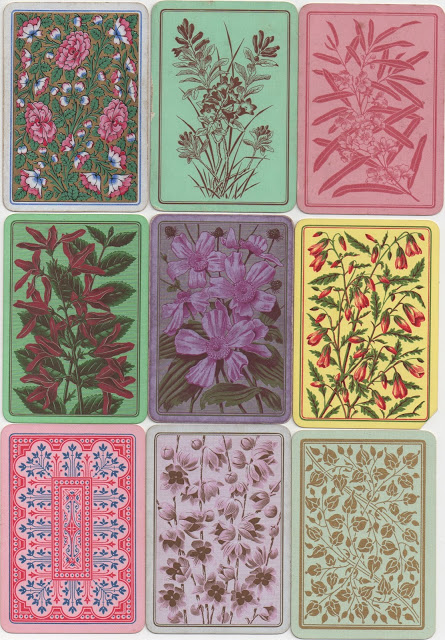
Above: A later selection by De La Rue from the 1880s (top row), 1890s (middle) and 1900-1910 (bottom)
For much more detail on Owen Jones's designs, see page 59.
As with all competition, once one producer opens up a lucrative market, others will follow. Goodall also produced a fine series of back designs from the 1860s onwards in particular. In this case we don't know the name of the designer(s), though John Leighton did produce some commemorative designs for the firm. The designs of the Old Frizzle period were for the most part of a very different style.

Above: Goodall designs, c.1850-62
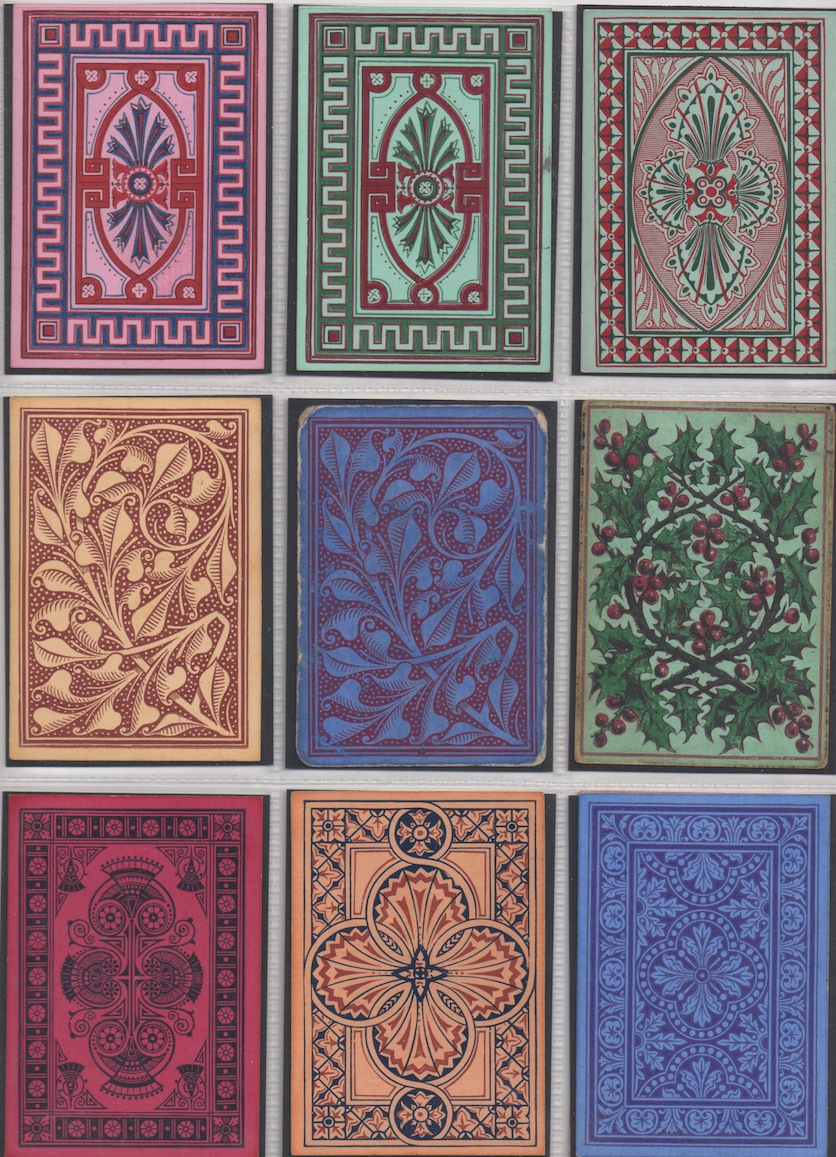
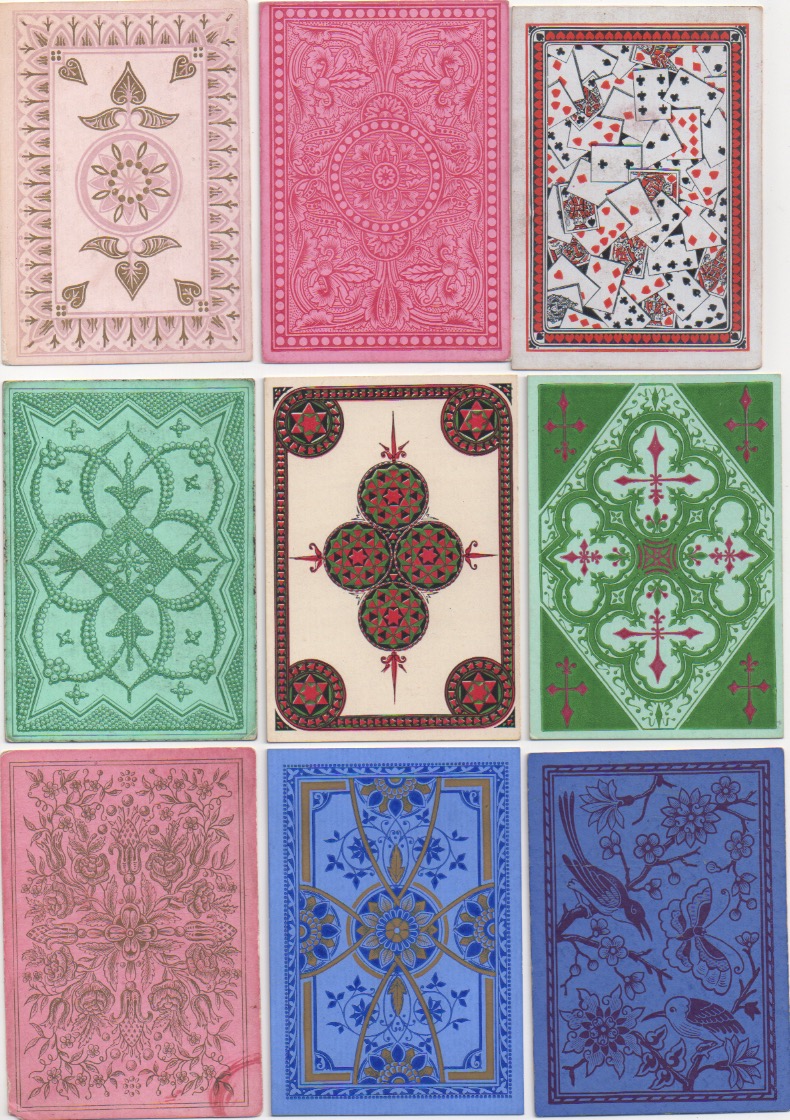

Above: Goodall designs, c.1862-75
The other main makers, Hunt, English, Woolley and Willis followed suit. Bancks never seem to have caught up with this new trend until the late 1870s, by which time it was too late for them. The following is another small selection of the period:

Above: Hunt backs, c.1870-80

Above: James English backs, c.1865-85
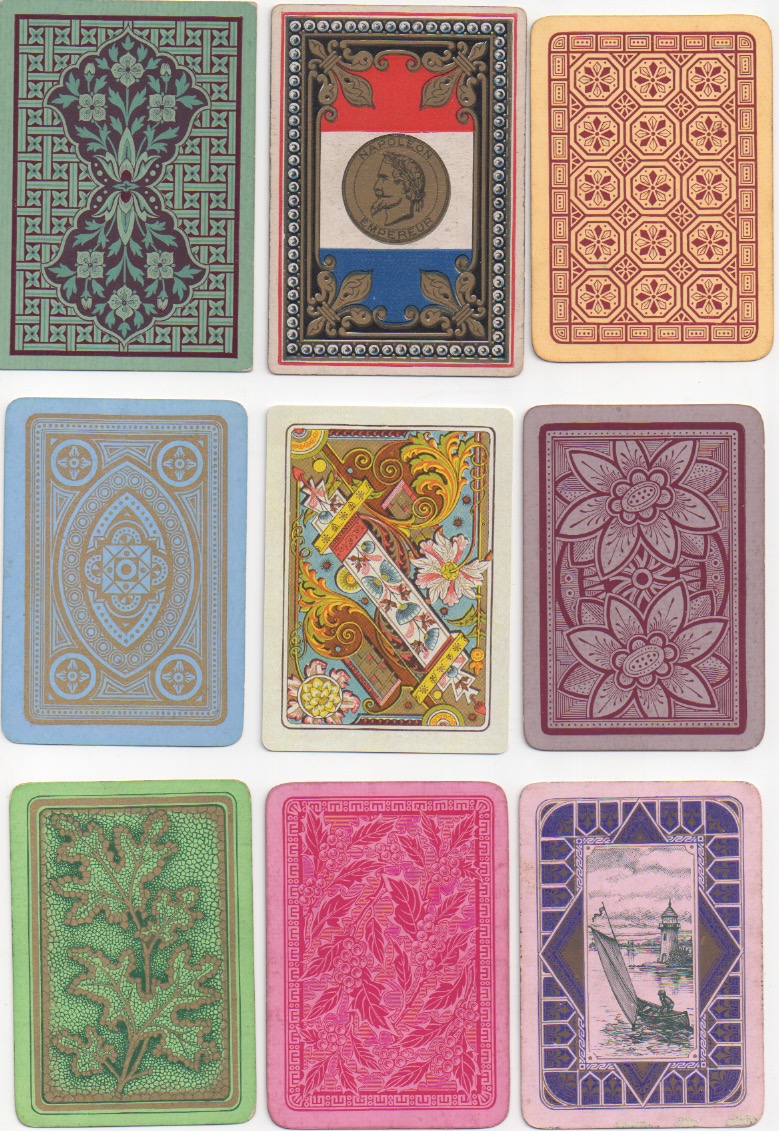
Above: Woolley backs, c.1870-95
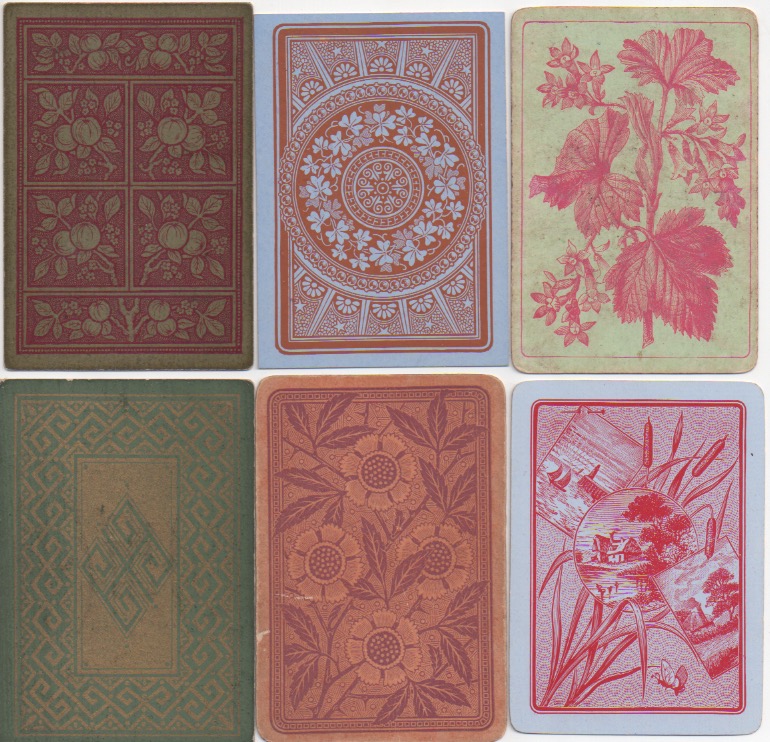
Above: Willis backs, c.1870-85
It's clear that several of the designs used by other makers take their inspiration from Owen Jones's work. Reynolds, on the other hand, has a particular place in all this. Although De La Rue were credited with inventing the decorative back design, such claims were hotly disputed by Reynolds & Sons. In 1870 they even wrote to The Stationer to the effect that it was their firm, in the person of their founder Joseph Reynolds, who introduced the first decorative backs, one in particular for the coronation of William IV in 1831, just before De La Rue even started. This brings us to a problem of identification. This pack is usually identified as the one illustrated below.
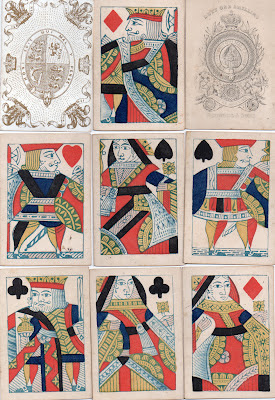
Above: Reynolds, Type III courts
The pack is also found with R1 courts, an in-house redrawing, and with double-ended courts with a post-Frizzle AS, both illustrated below. Details of these different versions and the different colour schemes on the backs can be found in Mark Irwin's book on royalty cards

Above: R1

Above: R2
The pack clearly refers to the Prince of Wales. This certainly could be William IV before he became king. If, on the other hand, it refers to the future Edward VII, then the pack must date initially from 1841 when he was born. The packs with R1 courts are likely to be later than this. The ones with a post-Frizzle AS may be a reissue for his wedding to Princess Alexandra of Denmark in 1863. What this back cannot be is a celebration of Queen Victoria's coronation, as suggested by some; the feathers do not relate to any royal female.
Other designs by Reynolds are illustrated below. They are of quite a different style from those of De La Rue and Goodall, though the strawberry plant on the bottom row, which is quite a late design, is modelled on those of De La Rue.

Above: Reynolds backs, c.1850-80
Even the smaller firms, Whitaker, Perry and Steer, had decorative backs on some of their cards, most of which seem to have come from Turnhout.
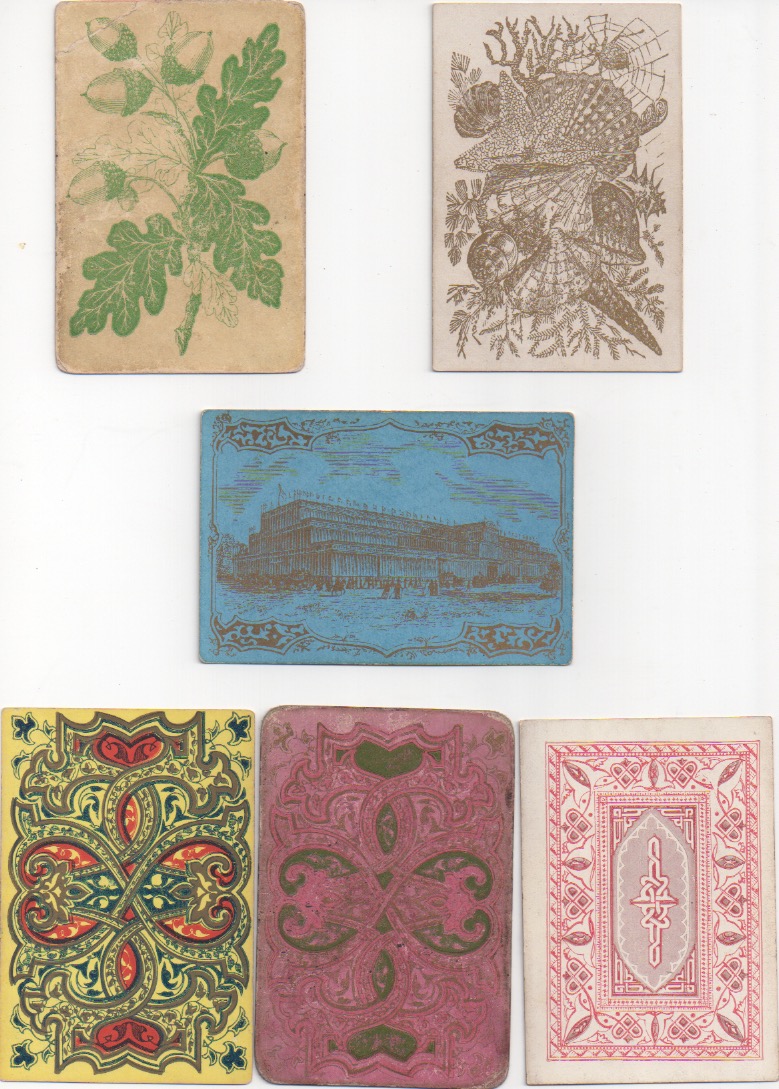
Above: top three by Whitaker, the landscape one for the Great Exhibition of 1851; bottom three: Whitaker/Steer/Perry
A further aspect of back designs is the extent to which they were copied by other makers, often in other countries. On page 59 and the associated linked texts I give examples of Owen Jones's design as used by Lawrence & Cohen and even plagiarised by Dougherty. Here are a few more intriguing examples, firstly from Samuel Hart.
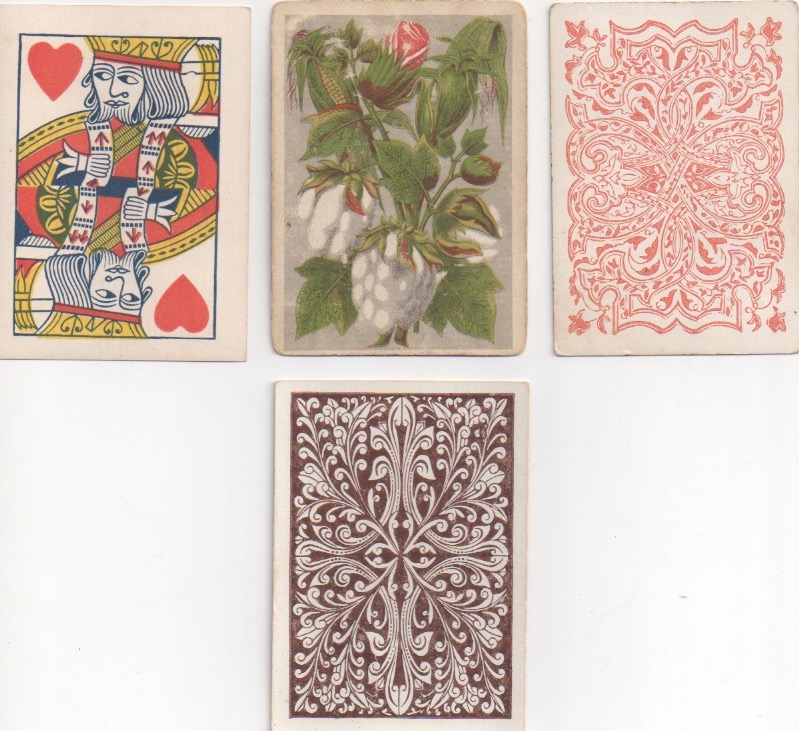
Above: Double-ended Faro courts with Jones's Cotton Plant backs; on the right is a back from a pack by Lawrence & Cohen, but in this case like the Whitaker and Perry backs above, though in a single colour. The bottom design is a copy of a Jones design for Highlanders in a single colour, but it has been engraved with slight differences from the De La Rue original and printed without the stippled background.
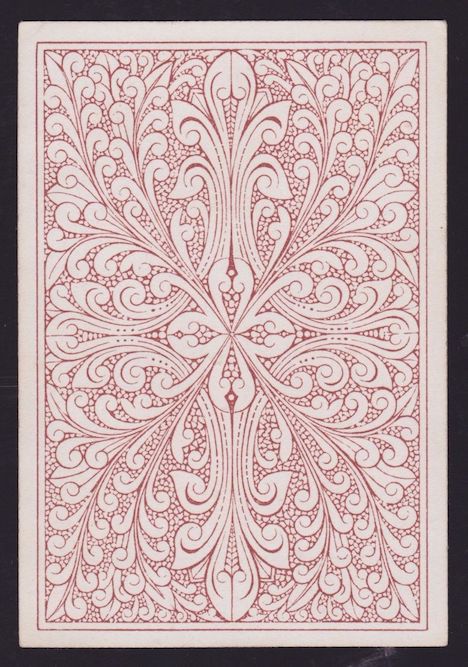
Above: De La Rue version of the figured design for Highlanders.
In the case of Lawrence & Cohen and Hart there was a commercial agreement with De La Rue dating back to L.I. Cohen to use Jones's designs, but as far as I know there was no equivalent arrangement with Goodall, and yet below we see a copy of one of Goodall's designs. As it is smaller than the original Goodall one, it, too, has probably been re-engraved.
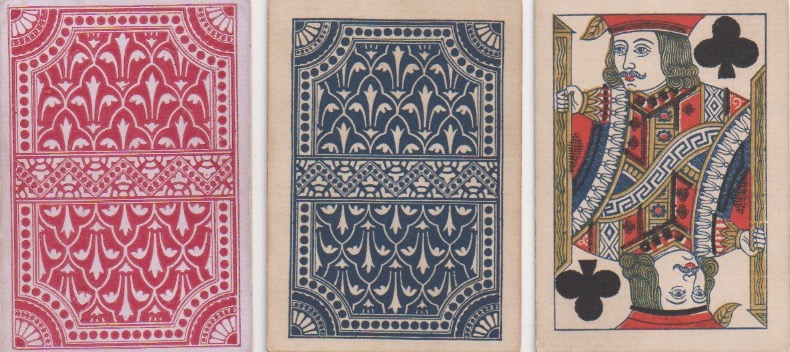
Above: the card on the left is by Goodall from the 1860s; the other two are by Hart copying both the back design and that of the courts (G3), though the heads have been redrawn.
An interesting aspect of back designs is the length of time some of them were used, with, in some cases, slight changes in the design brought about by redrawing. For example, the Goodall Shakespeare commemorative pack was first issued in 1864. Since it proved popular, it was republished a number of times until c.1917, even with square corners and no indices. There are variations in the backs from different periods, but the easiest way to date them is to use the court cards and ASs: the last edition (c.1917) has Limd on the AS and a London postal district number on the box (introduced in 1917), so they are good indicators of date. There are also those cases where the contract for a particular product goes from one maker to another. For instance, Johnny Walker cards were made by Goodall, then De La Rue after the take-over, but also by Waddington. I have a very odd mixed pack of Goodall/Waddington production. The backs are very similar, but are, in fact, from different plates. The advertising aces are also different. I illustrate some of the cards below.
Waddington --- Goodall
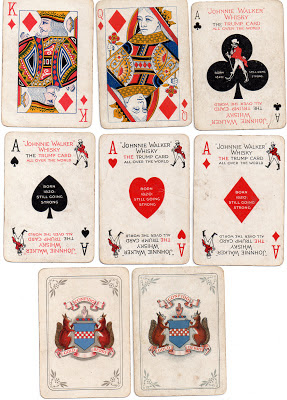
Goodall ------ Waddington
Another interesting whisky advert is the fairly common one for Dewar's The whisky of his forefathers. The two on the left are by De La Rue and Waddington respectively, and date from c.1930. But the green one on the right must be the original: it is called The spirits of his ancestors from a painting in the possession of the makers, William Mitchell & Co, Belfast, so it's for Irish whiskey (even though the spelling on the card is without the usual e). The firm was bought out in 1919. The cards are by Goodall with a London PC AS from c.1905. Whether the copyright was bought or the picture was just copied I wouldn't know, but Mike Goodall has sent me yet another version by Goodall of c.1910, which is clearly the forerunner of the later backs (bottom picture - sorry, it's cock-eyed!).
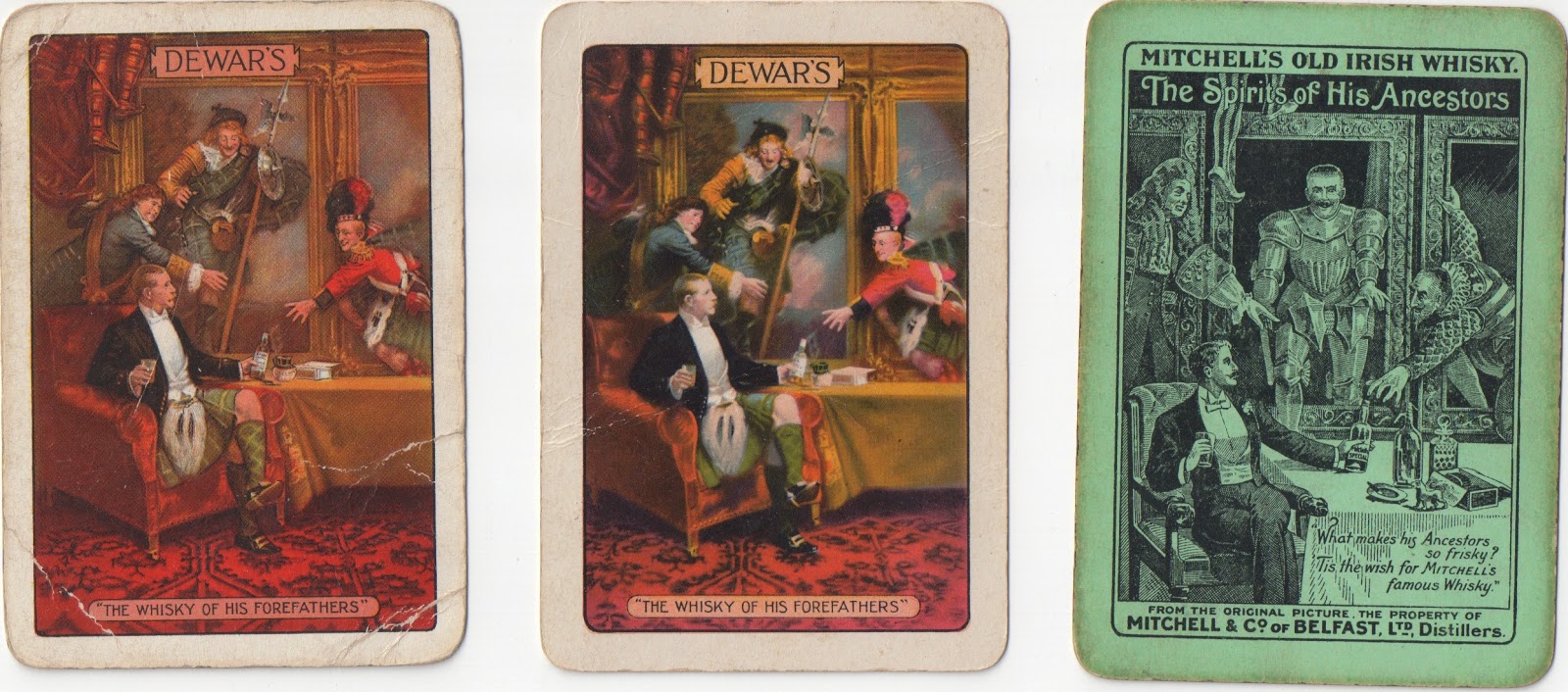
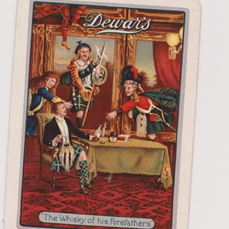
Even the Barribal Exide batteries back was printed by two makers: Waddington and Universal. They have slightly different details and colours.

Waddington (left) Universal (right)
The fronts of these cards show which maker made which; the score for no trumps (35) on the bridge score card from Universal dates it as 1928-32.

Waddington (left) Universal (right)
On the subject of Barribal, some time ago I acquired a wide-size pack with Waddington's first courts (W1) and Barribal's design No.101, Belgravia, which is also written diagonally on the padded lid of the box. (See also page 17.)
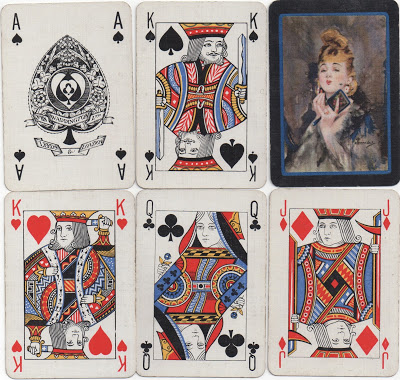
1922-23
And still with Barribal, here's an interesting and imaginative idea: to have a picture in two parts, one for each pack of a double box, which together make the whole picture. In this case the left half is in landscape, whereas the right is in portrait format. The designs are by Barribal: The Countess and Claude Duval, and when the box is open the packs make one picture. The illustration is from the bottom of the box, which reflects the arrangement inside with two decorated blocks, top and bottom, on either side of the landscape pack.

Waddington, c.1935
With the plethora of back designs clogging up the pages of eBay it seems redundant to illustrate many more, so here is one final sheet of 20th century offerings.
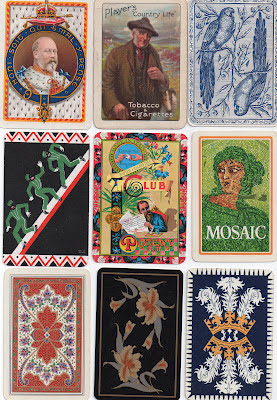
It is worth noting that there are a lot of poor descriptions of backs on eBay. Art Nouveau, Arts & Crafts and Art Deco are STYLES not periods; just because something was designed between 1890 and 1910 doesn't automatically make it Art Nouveau. In fact, Art Nouveau was not as popular in the UK as on the Continent of Europe, and very few card backs were affected by it. If you really want to know what Art Nouveau is all about, start with: https://en.wikipedia.org/wiki/Art_Nouveau. Also, backs from the 1950s often have a flavour of pre-war Art Deco. For example, the pair of backs depicting a Native American couple (perhaps, Hiawatha and Minnehaha) by Universal with an Art Deco influence (though note that the figures are not drawn in this style) appeared first in the late 1930s with three-colour courts and narrow indices (top row), but was still in use in the 1950s with four-colour courts, wider indices and an Alf Cooke AS (c.1955 onwards; bottom row).

Universal, c.1936 (top)
Alf Cooke, c.1960 (bottom)
The fronts of the cards can guide you here, as indicated above with the Universal packs; similarly, if a Waddington pack has Goodall courts, then it's from the 1950s or later, no matter what the back design is like. Waddington took over the printing of all Goodall/De La Rue cards in 1941 after the De La Rue factory at Bunhill Row was destroyed in the Blitz.
By Ken Lodge
United Kingdom • Member since May 14, 2012 • Contact
I'm Ken Lodge and have been collecting playing cards since I was about eighteen months old (1945). I am also a trained academic, so I can observe and analyze reasonably well. I've applied these analytical techniques over a long period of time to the study of playing cards and have managed to assemble a large amount of information about them, especially those of the standard English pattern. About Ken Lodge →

Leave a Reply
Your Name
Just nowRelated Articles
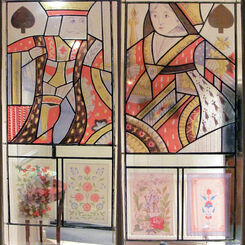
68: Playing cards in glass
My wife and I have recently commissioned a unique pair of stained glass windows for our home.

59: Owen Jones (1809-74) and De La Rue
A selection of examples of Owen Jones's artwork printed by De La Rue.
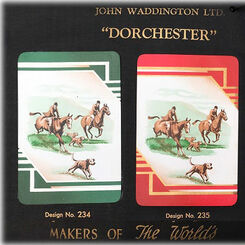
Waddington’s 1940 Trade Brochure
Waddington’s 1940 Trade Brochure.
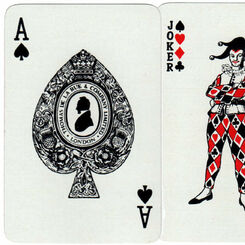
When three brands merge...
After De la Rue factories were bombed in 1940 their cards were printed by Waddingtons. In 1962 Waddi...

Help Yourself Society
The “Help Yourself” Society was formed in 1927 to run fundraising activities for hospitals.

41: A Guide to Dating Playing Cards
Dating is a particularly tricky but very interesting problem to tackle and there are many pitfalls. ...

33: Functional Changes to Playing Cards
The emphasis throughout my collecting has been on the design of the courts cards, and it should be p...
![28: How to Analyze and Differentiate Playing Card Plates (De La Rue, Waddington and the Berlin pattern [Französisches Bild]) 28: How to Analyze and Differentiate Playing Card Plates (De La Rue, Waddington and the Berlin pattern [Französisches Bild])](/core/cache-wopc-thumbs/var/www/wopc/production/www/images/contributors/kenlodge/4889-analyzing-playing-card-plates/JS_D1-D2-D3.4e1c4b9d.jpg)
28: How to Analyze and Differentiate Playing Card Plates (De La Rue, Waddington and the Berlin pattern [Französisches Bild])
My interest in postage stamp variants led me to apply the same principles to playing cards.

19: 19th Century Breaks with Tradition - Unusual versions of the Standard English Pattern
The centuries-long tradition of English court cards was subject to misinterpretation and in some cas...

17: Waddington, Including some of their Less Common Packs
John Berry's two-volume work on the Waddington archive and collection is a very comprehensive presen...

5: De La Rue
In December 1831 Thomas de la Rue was granted his patent for printing playing cards by letterpress.
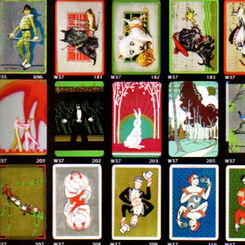
Waddington Back Designs
Waddington back designs ound in John Berry's Archi e olume, spanning rom the 1920s to the 1940s.

Jean Picart le Doux
Jean Picart le Doux playing cards, issued in 1957 to celebrate the company's 125th anniversary, feat...

Amalgamated Playing Card Co., Ltd
Agreement had been reached between Waddington's and De La Rue during the second world war for Waddin...

Owen Jones (1809-1874)
Owen Jones (1809-1874) was a Welsh architect and interior designer who designed the backs of playing...
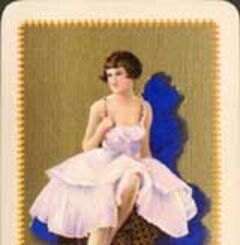
Waddington’s Encore Series
Waddington’s Encore Series 1933.
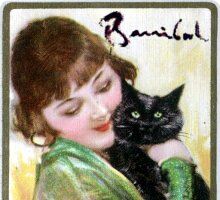
Barribal Series
William H. Barribal (1873 - 1956) was a London artist who created the Waddingtons 'Barribal' playing...
Most Popular
Our top articles from the past 60 days


 Your comment here. Your comment here. Your comment here. Your comment here. Your comment here. Your comment here. Your comment here. Your comment here. Your comment here. Your comment here. Your comment here. Your comment here. Your comment here. Your comment here. Your comment here. Your comment here. Your comment here. Your comment here. Your comment here. Your comment here. Your comment here. Your comment here. Your comment here. Your comment here. Your comment here. Your comment here. Your comment here. Your comment here. Your comment here. Your comment here. Your comment here. Your comment here.
Your comment here. Your comment here. Your comment here. Your comment here. Your comment here. Your comment here. Your comment here. Your comment here. Your comment here. Your comment here. Your comment here. Your comment here. Your comment here. Your comment here. Your comment here. Your comment here. Your comment here. Your comment here. Your comment here. Your comment here. Your comment here. Your comment here. Your comment here. Your comment here. Your comment here. Your comment here. Your comment here. Your comment here. Your comment here. Your comment here. Your comment here. Your comment here.




















